What to do if the geyser flows: an overview of the main causes and recommendations for their elimination
The use of a gas column is one of the best options for heating water in a house when there is no centralized water supply or the ability to receive hot water. The technique is very useful and independent of utilities. It uninterruptedly provides residents with hot water. However, these devices also fail for unknown reasons.
Undoubtedly, problems with such equipment should be solved by gas service employees with special permissions, because this is a requirement of safe operation rules. But there are malfunctions that can be completely eliminated on their own. Today we will analyze one of the frequent ones, which is associated with the flow of a gas column. Let's talk about what to do if the gas column is flowing, how to identify the cause of the breakdown and what actions can be taken. We also analyze the features of breakdowns that are inherent in various brands of gas water heaters.
The content of the article:
The main causes of gas leakage
A gas water heater is a difficult equipment that, with proper care, will please with a long uninterrupted operation. But, like all similar devices, it has its own service life. So, if you do not pay attention to the first malfunctions and problems in operation, you can reduce the operational life of the equipment.
Leaking and dripping from the column is not news. This problem is faced by many consumers. But only its timely elimination helps to keep the device in good condition. Guided by our article, you can eliminate dripping or leakage from a gas column, if this is not connected with the need for a complete replacement of equipment.
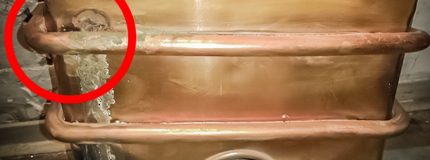
To know which way to fix the problem to apply (and there will be several), you need to determine the cause of the malfunction.
Similar malfunctions are possible in devices of any brands. Some models have a too vulnerable radiator, others have contact areas, others have a membrane, etc.
And, if you find a leak in your gas column, then perhaps the reason is one of the following:
- Deterioration of the connecting elements of the water flow. Most likely, it is necessary to change the rubber seals and gaskets that are located between the hose and the pipe.
- The heat exchanger has leaked and is now leaking water. The constant effect of fire on the metal surface of the coil causes microcracks. As a result, the burnt pipes. And then the first sign of a radiator breakdown is the accumulation of condensate. Water appears on the case and on the nodes of the column that are inside the device.
- Worn o-ring stem or diaphragm. Often, water starts oozing from a gas-water unit. The cause is often damage to the o-ring or membrane. The part (both) easily changes to a new one.
- Long-standing lack of preventive checks. As a rule, an unexpected leak is due to a lack of preventative maintenance.
When the water heater begins to leak, first of all, it is necessary to check the places of pipe supply. To determine the root cause, you need to remove the casing from the column and inspect it visually - the location of the leak indicates the breakdown. Only after determining the specific location and intensity of the leak can you start trying to eliminate the defect.
The casing is easily dismantled, since it is fastened only to bolts, and sometimes to latches. If you notice that water flows only when the boiler is on, you will need to start the heater at the time of the check, then turn it off again.
Before performing repairs, it is necessary to turn off not only the water supply, but also the gas.
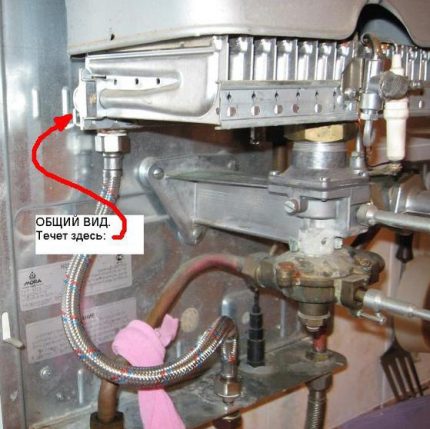
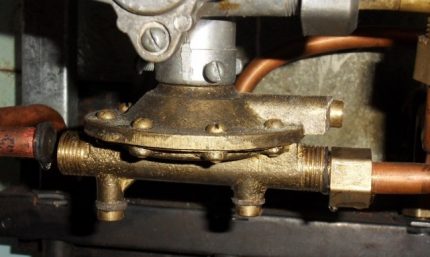
Causes of breakdowns and solutions
When you determine why your gas column has flowed, you can begin to fix the problem. There are several basic methods, and all of them depend on which part or element causes leakage. Next, let's talk about everything in more detail.
Reason # 1 - leaks at joints
In this case, leaks are eliminated quite simply. The main thing is to change the gaskets and reconnect again. Gaskets can last from 2 to 4 years. Therefore, they will need to be changed periodically.
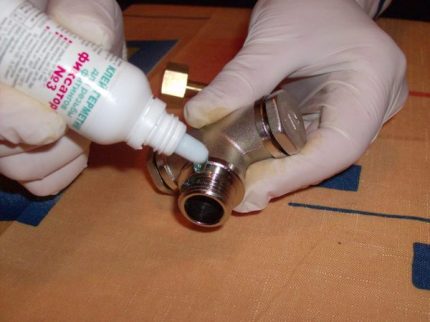
Let us consider in more detail the process of replacing gaskets, which will help get rid of leaks if the gas column passes water in the places of threaded connections. Usually nbegins to flow in the left tube of the column where the water is supplied.
To eliminate this, you need to:
- Shut off the water supply in the gas column.
- Carefully disassemble the problematic joint using a regular wrench. Immediately remove the gasket that has been worn.
- Clean joint components from rust and dirt. Be sure to degrease the thread and other elements of the connecting unit, and then dry.
- Replace gasket with a new one.
- Collect the connection.
All connections should be carefully inspected for leaks. When looking for enough visual inspection - such problems are noticeable even to a beginner.
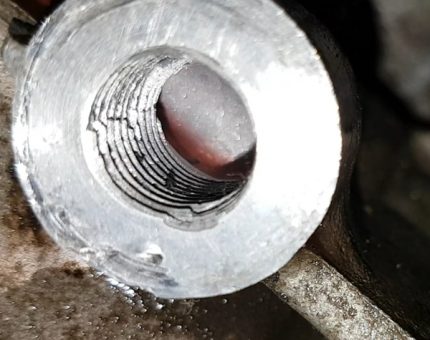
Reason # 2 - diaphragm and stem gasket wear
To eliminate leaks in the area of the water reducer, it will be necessary to change the gaskets (seals) on the stem.
Do not forget about the spring. It should be checked for performance. Often these elements wear out, causing leaks.
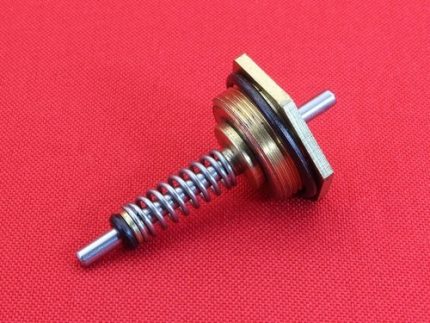
The oil seal changes easily as follows:
- The water unit is fastened with screws, they should be unscrewed at the beginning of the work process.
- Separate the two parts of the body of the water unit.
- Remove the membrane, spring and plate with the stem (round disc with a metal pin).
- By removing the pin, you can see the rubber ring. This is a sealant. It must be removed by installing a new oil seal.
Next, a new membrane is installed. Its service life is often 5 years, sometimes 8.
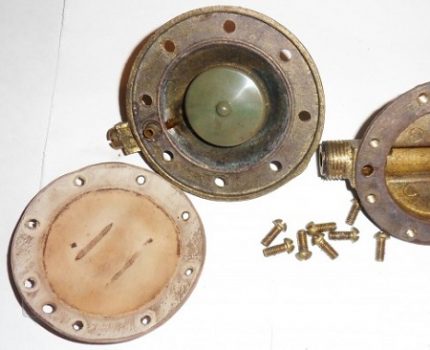
The necessary spare part is replaced - instead of worn out membranes a new one is being installed.
The internal cavity of the gearbox needs to be cleaned. Therefore, accumulated sand and other debris are removed. Then it remains to assemble the gearbox in the reverse order and reinstall.
Reason # 3 - heat exchanger leaks
Sometimes, in order to understand why water flows from your gas column, it is enough to detect the accumulation of condensate. The fluid collects on the body and inside of the gas column. The so-called perspiration.
However, everything is much more serious than it seems at first glance. Such signs indicate problems with the heat exchanger (radiator, coil) - water drops form in its individual sections.The main cause of the leak is the presence of cracks or holes. Fire for a long time affects the metal, burning it gradually and rather slowly.
It will definitely be a heat exchanger replacement or soldering of a damaged area.
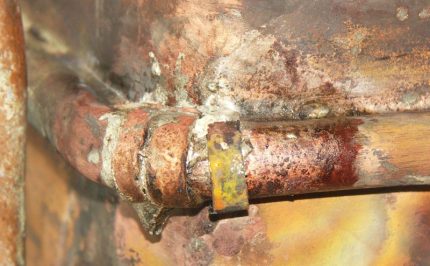
The troubleshooting scheme is as follows:
- The water pipes must be closed so that the water no longer enters the column.
- Disconnect water hoses from the equipment. All water must be drained from the radiator. To completely drain it, it is better to use a compressor or vacuum cleaner.
- To clean places of damage with an emery paper. Degreased and dry prepared areas.
- Solder.
For soldering, you need a soldering iron and solder, which can be used at temperatures above 180 degrees. Note that the soldering iron should be quite powerful - from 100 watts.
You can also use for soldering gas burner.
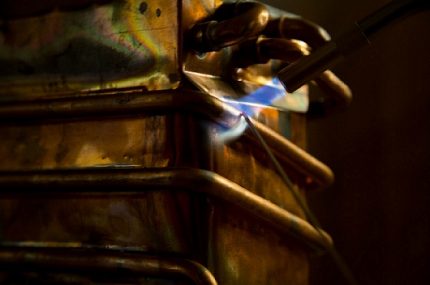
When soldering, one should not miss a single crack, even a minor one. Because every slightest deformation and microcrack will cause the formation of condensate, which means the column will leak.
We have a more detailed website heat exchanger repair instruction do it yourself.
Reason # 4 - lack of maintenance
In this case, we are talking about regular preventive measures for servicing gas-using equipment, for which you should attract qualified specialists from the gas company with which you contract signed.
If you do not carry out the service on time, then the column will fail much earlier. So, for example, from the abundance of scale, the efficiency of heating the water will decrease, and cracks will form on the copper tubes. And then you need to change the heat exchanger, which will cost quite expensive. Or solder.
But a number of events on service (cleaning the individual elements of the column from soot, scale and dirt) can be done by yourself.
Difficulties in repairing different speaker models
If we take into account the geysers of all brands and models, then the causes of leakage are almost the same. However, if we consider the brands of devices separately, we can point to certain breakdowns that often occur in the gas column of a manufacturer.
Consider the example of brands popular among buyers. If you use one of the columns below and it flows, then it will be easier for you to find the cause of the leak.
Reasons for leakage of Neva columns
If the Neva gas column is flooded, then the leak is caused by the following defects:
- membrane malfunction;
- stem seal is leaking;
- the integrity of the stem plate is broken.
Speaking about this brand of gas boilers, it should be noted that it is very difficult to eliminate the leak of the stem seal. The complexity is caused by the connecting bolts of two compartments - gas and water. They are quite difficult to unscrew. Often when trying to repair, the bolts break.
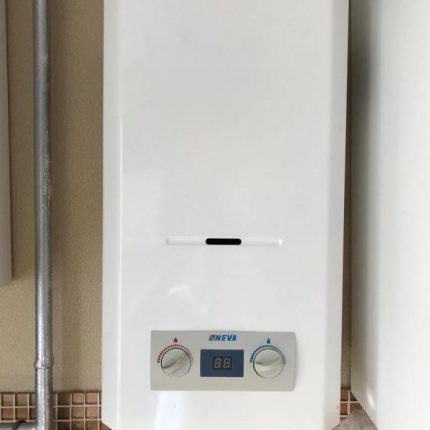
Leak in geysers "Junkers"
Liquid leakage in a Junkers heater occurs more often for the following reasons:
- failure of the radiator;
- damage to o-rings - in old models they are dried, which leads to the formation of leaks from the column;
- the formation of cracks in the duct regulator (the place of attachment of the "frog");
- natural membrane wear.
In the first case, it will be necessary to carry out soldering work, in the second and possibly the third, it will be necessary to replace the sealing rings.
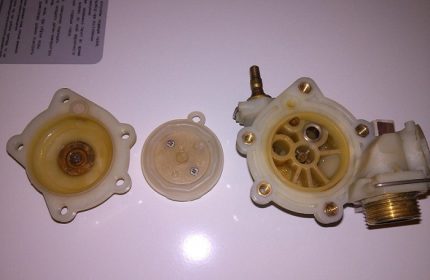
Problems with Ariston Water Heaters
Those with a company column "Ariston, talk about leaks at the bottom of the device. The problem is flange gasket wear. The problem is solved by replacing it. To do this, the column is disconnected from the network and all the water is drained. After the cover is removed, the flange is removed and the gasket is replaced.
Another problem with these columns is depressurization of joints. The best solution is to seal the joints with a sealant.
Reasons for leaking speakers of other brands
Service centers are more likely to encounter customers who own the company’s columnBosch. And, almost always, the course is caused membrane wear. For this reason, experts recommend having this part in stock. And timely clean the device from scale and dirt.
Geysers "Oasis" flow due to a faulty stem seal that needs to be replaced. More about this process, as well as an overview of other breakdowns of the speakers of this brand and how to repair them, we reviewed in our other article.
Speakers company Astra» begin to flow most often for two reasons - defects at the joints and a leaky heat exchanger. Workaround - soldering copper tubes, more effective and longer - replacement radiator.
Conclusions and useful video on the topic
Often, the problem of gas column heat exchanger leak is eliminated by soldering the tubes. However, not everyone in the house will have the necessary tools and materials. There is an alternative way to solve the problem - without soldering. How to do this, see the following video:
Eliminating a leak of a water heater of any brand is not a complicated procedure - all the work can be done independently, having a standard set of tools in the house.For this, it is not necessary to have special skills and knowledge, but rather use the above instructions and do not forget about safety regulations when using gas equipment.
And if during the repair process with your own hands you found a gas leak, you should immediately call the gas workers.
Do you want to talk about your own experience in eliminating gas leakage? Or do you have your own opinion about the feasibility of an independent search for the cause of the leak, and further repairs on your own? Express your opinion, share experiences, participate in discussions - the comment form is located below.

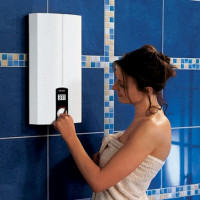 Which is better - a gas water heater or an electric water heater? Comparison of the main parameters
Which is better - a gas water heater or an electric water heater? Comparison of the main parameters 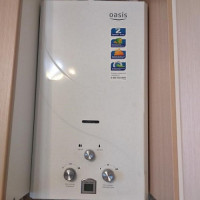 Oasis gas column repair: an overview of typical breakdowns and recommendations for their elimination
Oasis gas column repair: an overview of typical breakdowns and recommendations for their elimination 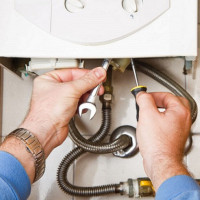 Why the geyser does not heat water: diagnostics of malfunctions and methods of their elimination
Why the geyser does not heat water: diagnostics of malfunctions and methods of their elimination 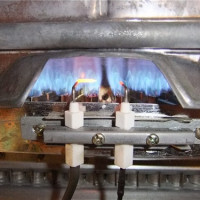 Why the geyser turns on with cotton: finding the cause and tips for repairing the breakdown
Why the geyser turns on with cotton: finding the cause and tips for repairing the breakdown 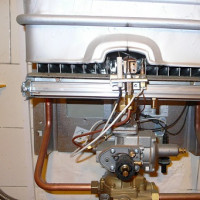 Why the geyser buzzes, clicks, whistles and pops: causes of problems and solutions
Why the geyser buzzes, clicks, whistles and pops: causes of problems and solutions 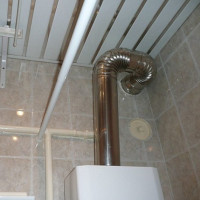 What to do if the chimney flue freezes: effective ways to protect the chimney
What to do if the chimney flue freezes: effective ways to protect the chimney  How much does it cost to connect gas to a private house: the price of organizing gas supply
How much does it cost to connect gas to a private house: the price of organizing gas supply  The best washing machines with dryer: model rating and customer tips
The best washing machines with dryer: model rating and customer tips  What is the color temperature of light and the nuances of choosing the temperature of the lamps to suit your needs
What is the color temperature of light and the nuances of choosing the temperature of the lamps to suit your needs  Replacement of a geyser in an apartment: replacement paperwork + basic norms and requirements
Replacement of a geyser in an apartment: replacement paperwork + basic norms and requirements